July 18, 2025
Air Date: July 18, 2025
FULL SHOW
SEGMENTS
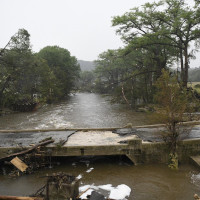
Weakening Disaster Prep
View the page for this story
Weather forecasting, climate research and climate resilience are being hit with major budget and staffing cuts by the Trump administration. Alice Hill is a senior fellow at the Council on Foreign Relations who served on the National Security Council under President Obama, and she joins Host Jenni Doering to discuss how recent federal cuts can impact emergency preparedness for floods such as the one that devastated the Texas hill country. (12:15)
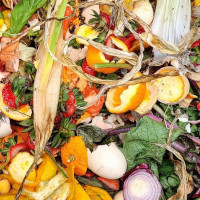
NYC Recycling Food and Yard Waste
View the page for this story
A few months into New York City’s mandatory curbside composting policy, there are still some kinks to work out, and enforcement and fines have been temporarily paused. Eric Goldstein, the New York City Environment Director at the Natural Resources Defense Council, catches up Host Aynsley O’Neill on how the program is going and why composting food and yard waste can save money, benefit landfills, reduce NYC’s carbon footprint, and help gardeners. (11:37)
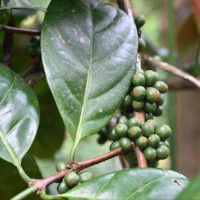
Climate-Resilient Coffee
/ Sophia PandelidisView the page for this story
Research has long shown that the top two coffee species, Arabica and Robusta, are vulnerable to climate impacts like increased drought and heat. And by 2050 as much as half of coffee producing land could no longer be suitable for these top species. But Living on Earth’s Sophia Pandelidis reports that excitement is brewing over a climate resilient bean called excelsa. (06:45)
Clearing Air in Cancer Alley
View the page for this story
Residents of Reserve, Louisiana in “Cancer Alley” recently received stunning news that Denka Performance Elastomer, which has for years emitted high levels of cancer-causing air pollutants, would indefinitely suspend its operations. Tish Taylor of Concerned Citizens of St. John speaks with Host Jenni Doering about illnesses her family has endured, her community’s cautious celebration of the decision and cleaner air and how her fight against environmental racism continues. (14:51)
Show Credits and Funders
Show Transcript
250718 Transcript
HOSTS: Jenni Doering, Aynsley O’Neill
GUESTS: Eric Goldstein, Alice Hill, Tish Taylor
REPORTERS: Sophia Pandelidis
[THEME]
O’NEILL: From PRX – this is Living on Earth.
[THEME]
O’NEILL: I’m Aynsley O’Neill.
DOERING: And I’m Jenni Doering.
Amid worsening weather disasters, federal climate resilience programs are on the chopping block.
HILL: FEMA, and the Trump administration, terminated all the grants that were outstanding and have said this will not go forward. This has been devastating to communities who were counting on federal money to help them get better prepared.
O’NEILL: Also, brewing a more climate-resilient cup of coffee with a little known variety called excelsa.
SABLE: We always found that even if the Arabica suffered or the Robusta suffered due to climate change, excelsa was something that would always give us a medium crop without any intervention. They are extremely strong plants.
O’NEILL: Those stories and more, this week on Living on Earth. Stick around!
[NEWSBREAK MUSIC: Boards Of Canada “Zoetrope” from “In A Beautiful Place Out In The Country” (Warp Records 2000)]
[THEME]
Weakening Disaster Prep
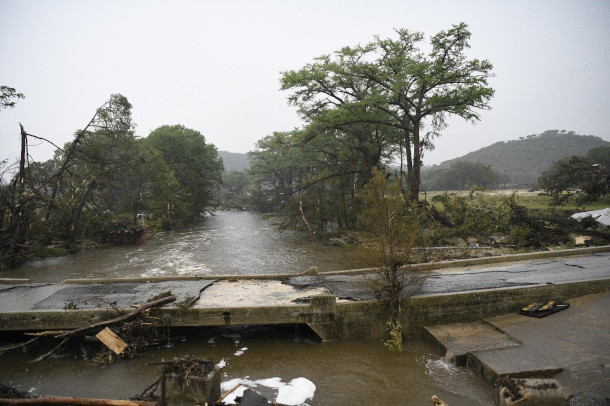
Devastation from the July 4, 2025 floods in Central Texas. (Photo: World Central Kitchen, Wikimedia Commons, CC BY 4.0)
O’NEILL: From PRX and the Jennifer and Ted Stanley Studios at the University of Massachusetts, Boston, this is Living on Earth. I’m Aynsley O’Neill.
DOERING: And I’m Jenni Doering.
Weather forecasting, climate research, and climate resilience are being hit with major budget and staffing cuts by the Trump administration. And this all comes at a time when the US is experiencing extreme rainfall supercharged by a hotter atmosphere that can hold much more moisture. Recent flash floods have devastated parts of Texas and wreaked havoc in states across the Northeast, New Mexico, and North Carolina. Joining us now to discuss how recent federal cuts can impact emergency preparedness is Alice Hill, a Senior Fellow for Energy and the Environment at the Council on Foreign Relations. She also served as the Senior Director for Resilience Policy on the National Security Council and as a Special Assistant to President Obama. Welcome to Living on Earth, Alice!
HILL: Well, thank you for having me.
DOERING: So I understand that there are a number of Trump administration cuts to disaster preparedness and climate resiliency that have already taken place. Can you walk us through some of those?
HILL: The Trump administration has taken steps that will curtail emergency preparedness and actually reduce the capacity of the United States to respond to disasters. The most immediate of those things that have already occurred is that staff cuts took place, and those took place through the DOGE process under Elon Musk's leadership. Many senior members of FEMA, the Federal Emergency and Management Administration, took the buyout offer and left, and that meant that senior administrators were unavailable going forward to help with future disaster recovery as well as planning and preparedness. There have also been steps to reduce training offered by FEMA. FEMA has historically, in recent years, trained emergency managers from across the states, and the reason why that's so important is that you want emergency managers in one county to be able to easily communicate with members of Emergency Management from an adjoining county or a nearby county. We know that these disasters do not honor our jurisdictional boundaries. They cross borders. So you need to have the personnel that's responsible for taking care of a disaster be able to communicate easily, and FEMA stepped into that to provide training. It also provides grant funding to help communities prepare themselves and as well as reduce the risk going forward, and the Trump administration has terminated one of the most important programs for building resilience that's called the Building Resilient Infrastructure and Communities program.
DOERING: And why was that program so important?
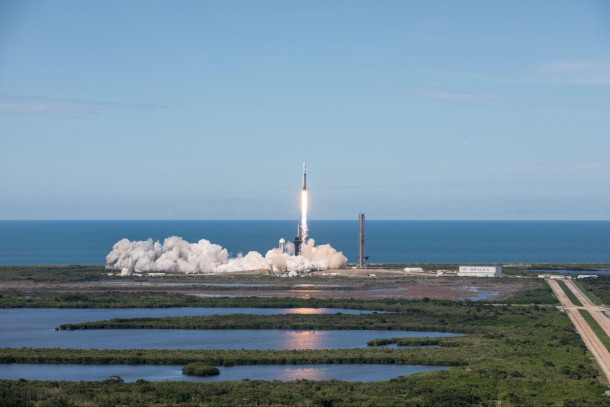
The National Oceanic and Atmospheric Administration, NOAA, conducts climate research through weather-observing and environmental monitoring satellites like NOAA’s GOES-U satellite, pictured above during its launch. (Photo: Kevin O'Connell & Kevin Davies, NASA, Flickr, Public Domain)
HILL: That program, it's known as BRIC, really presented a sea change in terms of the amount of money that the federal government invested in disaster risk reduction. Now studies have shown, one of them from the National Institute of Building Sciences, another from the US Chamber of Commerce, have shown that for every dollar invested in risk reduction, there's a huge payoff. It can be up to $13 according to the Chamber of Commerce. FEMA and the, this NIBs study, the National Institute of Building Sciences, estimates that investment, for example, in stronger building codes will save $11 in damages for every dollar invested. So this BRIC program took about 6% of what the nation spends, up to 6% of what the nation spends on disasters, and put that to reducing risk in advance, pre-disaster risk reduction. It covered things like moving homes away from flood areas, better building in wildfire zones to make homes more fire resistant, protecting wastewater treatment plants. The program was wildly popular. Ironically, it was started under President Trump during his first administration, but in April, FEMA and the Trump administration terminated all the grants that were outstanding, and have said this will not go forward. This has been devastating to communities who are counting on federal money to help them get better prepared, and the program has already given close to $5 billion in grants in the short time that it's been in place.
DOERING: So those are some of the cuts to FEMA that have been happening under this second Trump administration. What about cuts to the National Oceanic and Atmospheric Administration, or NOAA, which does a lot of weather and climate science? How are those cuts impacting climate resiliency and disaster preparedness across the US?
HILL: Well, NOAA is widely viewed as the premier meteorological service in the world. Other countries depend on NOAA's work in determining what are the changes to the weather, to the climate that are occurring currently, and what we should learn and understand about those changes in terms of how we can better protect people and property. The cuts, similar to FEMA, first were to staff, so there have been a lot of staff reduced at NOAA and reports of, for example, meteorologists being let go, and the meteorologists are key to creating weather predictions, weather forecasts, and those weather forecasts then in turn inform early warnings, and early warnings in turn allow people to take action before disaster strikes, to reduce harm, save lives and take care of their property. These cuts to staff have meant that forecasts are at risk for accuracy and the ability to have full input from the collection of data to make sure that they're the most robust forecasts that they can be. And of course, if you don't have a robust forecast, you could be very surprised by an event, and that will cause more damage.
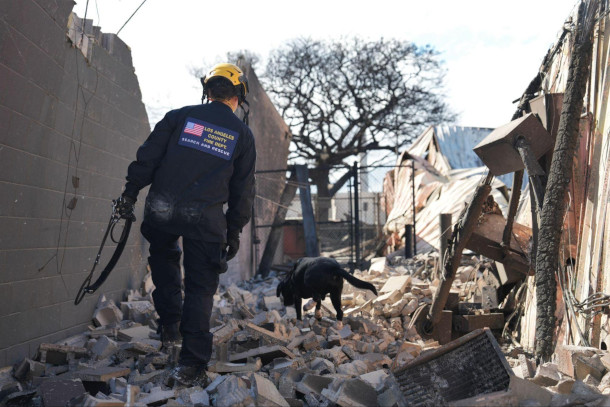
FEMA Urban Search and Rescue teams work alongside the National Guard, as well as local fire departments in the Hawaii Wildfires. Shown here, the Los Angeles County Fire Department sent their rescue team to aid in operations. (Photo: Dominick Del Vecchio, FEMA, Wikimedia Commons, Public Domain)
DOERING: When a disaster hits, obviously it's a horrible thing, but what's the usual protocol? Like, who is the first to act? You know, states or the federal government?
HILL: Well, the first to act is the local community, and then the states. And then, under our system, FEMA is called in when the state and local territorial tribal governments are overwhelmed. That's when you call the cavalry, and FEMA is the cavalry. So the plan is that if a state is overwhelmed by a catastrophe or a local government, local government turns the state, and then the state can turn to FEMA and call in help to handle something that's really beyond the capabilities that they would normally have. So you can think of a small, localized flood the state and local leaders would respond to that, but if it's massive flooding, then they're going to need FEMA to help them, because they'll need capabilities like search and rescue teams. They'll need additional food, water, housing for people displaced by the disasters and they may in a wildfire, need help with firefighting teams from other jurisdictions to come in, and FEMA can assist with that if the state doesn't have those relationships pre-existing to do this on their own.
DOERING: The fiscal year 2026q5u federal budget that the Trump administration has proposed is still just a proposal at this point, but I understand that it includes a number of significant cuts to disaster preparedness and climate resiliency. For example, 10 NOAA labs would be closed, including one that develops accurate flash flood forecasts. How would these proposed cuts change the way the federal government helps communities better prepare for climate disasters?
HILL: Well, the proposed cuts, particularly to NOAA, would really undermine our ability to understand how the climate is changing, and what we see repeatedly is that a terrible event will occur. Media will be deployed, and they'll come out and interview victims, and the victims will say, I've never seen anything like this before, even though I've lived here 40, 50, whatever amount of years. Well, with climate change, we will see many more events that are bigger than anyone has experienced in human history. So the work that NOAA was doing through those 10 laboratories and other programs was designed to help us better understand how big can those events get? How are they unfolding, and what can we do to protect ourselves from them? So the shutdown of those laboratories, and that climate science research fundamentally kneecaps the ability of the United States to understand what is occurring and what is ahead, and that means we will be less prepared.
DOERING: Now the Trump administration has also disbanded the 400 scientists involved in the National Climate Assessment. Why is that significant? And in the past, how has that assessment helped communities across the US face climate disruption?
HILL: The Trump administration is cutting information to states and communities regarding their risk. The National Climate Assessment, that's a congressionally mandated report. It comes out about every four years, and I served on an advisory committee for the Third National Climate Assessment. The purpose of that assessment is to inform Americans about the nature of climate risk in the United States. It tells them, by region, what kind of risks they can expect. For example, in northeast, we're experiencing flooding in Vermont, that report will tell you, in the northeast, we'll see very extreme flooding. In the Western United States, we're seeing drought and wildfires. That report would also detail how that is unfolding and how it's anticipated to unfold in the future. I also covers critical infrastructure. So what's happening to water availability? In drought areas you're not going to have a strong water access. What's happening to wastewater treatment when areas flood? Often wastewater treatment is for obvious reasons, at the bottom of the hill, and it gets flooded out and we need to protect those facilities so that they can continue to operate even in heightened flood conditions. So that program, the National Climate Assessment, is on pause. The 400 volunteer scientists who were contributing to that report have been told the program is dismantled, and then we have removed from public websites information about climate risk. That means that communities are flying blind. If they don't have the money that a New York or California has to hire private consultants, they are at great risk of underestimating what's going to happen, and therefore not making adequate preparations.
DOERING: Right and, you know, I imagine that decisions such as whether to rebuild after a flood or, you know, after a wildfire, just not understanding those risks and the likelihood that those kinds of things are going to maybe keep happening could really be dangerous for communities.
With Trump’s exit from the #Paris #climate agreement, all countries—including the US—should amp #adaptation efforts. “Drill, baby, drill” =“Fry, baby, fry.”As CA’s #wildfires have revealed we don’t know how to adapt to the heat that’s already here—much less what’s ahead www.cnn.com/2025/01/20/c...
— Alice C. Hill (@alice-c-hill.bsky.social) January 20, 2025 at 5:30 PM
[image or embed]
HILL: Absolutely, that is exactly the kind of information in that crisis moment everyone wants to rebuild, but it would be helpful to know, and firefighters will tell you, if it's burned once, it's likely to burn again, or if that last flood you thought was big, you can expect even larger floods in the future unless there's increased flood protections put in place. you're absolutely right That's the kind of information communities desperately need to make better informed, more fiscally sound decisions. Decisions that also save lives.
DOERING: Alice Hill is a Senior Fellow for Energy and the Environment at the Council on Foreign Relations, who also served on the National Security Council under President Obama. Thank you so much, Alice.
HILL: Thank you. What a pleasure.
[MUSIC: Chet Baker, “All Blues – 2024 Remastered Version” on Round Midnight 79 (2024 Remastered Version), Diggers Factory]
O’NEILL: Climate disasters are taking a toll on national treasures including the iconic Grand Canyon Lodge, destroyed in recent days by a wildfire. Next week we plan to cover the Trump administration cuts to the National Park Service, and we had the chance to ask our guest, public historian Donna Graves, about the impact of this fire. Here’s a taste.
GRAVES: In a place like Grand Canyon, a fire destroys cultural resources, but obviously the landscape itself, and that landscape is so meaningful to traditional people who have lived there for a millennium and to the millions of visitors from across the United States and around the world who come to see this iconic landscape that represents our nation. To not be able to protect those, which I'm concerned, about both because the administration is defunding Park research on climate change, but also because this administration seems to be wanting to defund preparedness in response to climate change disasters, I fear that so many of the places we love are going to suffer that same fate that the Grand Canyon did.
O’NEILL: Tune in next week to hear that and more.
Related links:
- Learn more about Alice Hill
- Yale Climate Connections | “Cuts to NOAA Increase the Risk of Deadly Weather Tragedies”
- The Guardian | "Trump administration sued by 20 states for cutting disaster prevention grants"
[MUSIC: Chet Baker, “All Blues – 2024 Remastered Version” on Round Midnight 79 (2024 Remastered Version), Diggers Factory]
DOERING: Coming up, a cuppa joe that can weather the storms of climate change. Stay tuned to Living on Earth!
ANNOUNCER: Support for Living on Earth comes from the Waverley Street Foundation, working to cultivate a healing planet with community-led programs for better food, healthy farmlands, and smarter building, energy and businesses.
[CUTAWAY MUSIC: Chet Baker, “All Blues – 2024 Remastered Version” on Round Midnight 79 (2024 Remastered Version), Diggers Factory]
NYC Recycling Food and Yard Waste
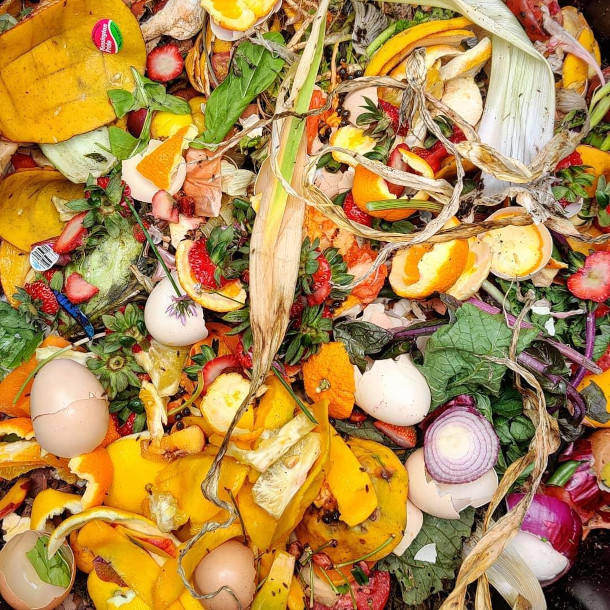
New York City generates roughly 24 million pounds of trash daily. Approximately one-third of that is food and other organic waste. (Photo: Niwrat, Wikimedia Commons, CC BY-SA 4.0)
DOERING: It’s Living on Earth, I’m Jenni Doering.
O’NEILL: And I’m Aynsley O’Neill.
New York City is the most densely populated city in America, and home to more than 8 million people. Now, multiply that by the 400 pounds of food waste generated per person per year, and suddenly the Big Apple doesn’t seem so fresh. Food waste has long been a tough issue to tackle, and while composting isn’t new to New York City, a recent mandatory curbside composting policy may finally give it the momentum it needs to make real progress. Enforcement began earlier this year before being paused, and a few months in, there are still some kinks to work out. Currently only one-fifth of collected food waste actually makes it to the composting facility on Staten Island. But the scraps that are sent there not only help landfills reduce their carbon footprint, the compost itself is given away to NYC residents, who can then use it to close the circle and fertilize their gardens or window boxes. To understand the ins and outs of NYC’s new program, we called up Eric Goldstein, the New York City Environment Director at the Natural Resources Defense Council. Eric, welcome to Living on Earth!
GOLDSTEIN: Thank you, Aynsley, nice to be here.
O'NEILL: So as awareness around sustainable waste management grows, composting is increasingly taking a sort of center stage. So what are the key benefits of composting? Why is it important?
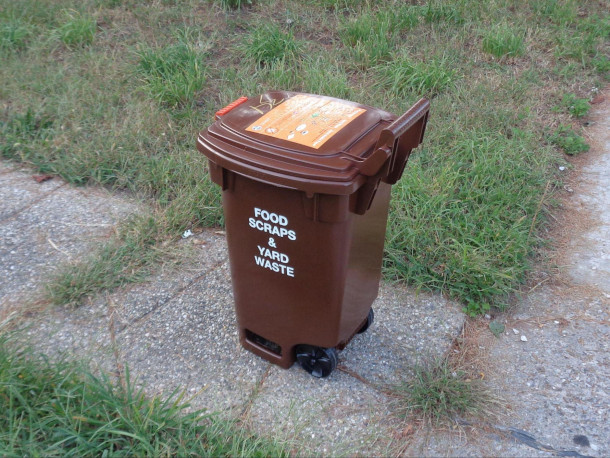
A mandatory composting program by the New York Department of Sanitation that began in 2025 requires residents to properly dispose of food waste in designated bins. (Photo: T Dorante, Wikimedia Commons, CC BY-SA 4.0)
GOLDSTEIN: Well, composting is one of the most important pieces of the nation's unfinished solid waste agenda, and right now, most of the food scraps and yard waste that we generate is sent to landfills and incinerators. Both of them are problematic. In landfills, when organics are buried, they break down and decompose and generate methane, which is a very potent global warming gas. And if we send food scraps and yard waste to incinerators, and we're not big fans of incinerators anyway, but since they have such high moisture content these food waste and yard waste, they foul up the burning process. It's like throwing a wet log onto a campfire, and so it cools the temperature and generates more pollution in the local areas where those incinerators are sited, and that's often in environmental justice communities. So neither landfilling nor incineration are the place where food scraps and yard waste ought to be going. Organics are the single largest portion of the nation's municipal waste stream, and we can handle them sustainably, and that will be a plus for our environment, our air quality, climate change, as well as saving taxpayers money. And in contrast, when we send our organic materials to a composting facility, we turn those materials previously thought of as waste into finished compost that can be used as a natural fertilizer to help in the growth of street trees, plants, community gardens, and we've taken a material thought of as a waste product and turned it into a useful material that helps us live more sustainably.
O'NEILL: And New York City decided they wanted to buckle down on composting. So what exactly does mandatory curbside composting mean for New York City residents?
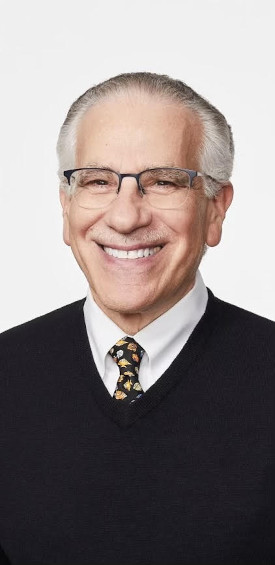
Eric Goldstein is a senior attorney and New York City Environment Director at the Natural Resources Defense Council. (Photo: Courtesy of Eric Goldstein)
GOLDSTEIN: Well, New York is now the largest city in the nation that has curbside collection of food scraps and yard waste and so on a weekly basis, just as the city officials in their sanitation trucks come around and collect the ordinary trash and recyclables like metals, glass and plastic, they are now collecting organics, food scraps, and yard waste separately so that they can be composted and turned into a useful end product.
O'NEILL: And Eric, at what point do people start to get fined or penalized for not complying with this program?
GOLDSTEIN: Originally, enforcement started earlier this spring, but several elected officials noted that there had been insufficient public education activities and not enough people knew about the program, so the sanitation department has chosen to hold off on enforcement until the end of the year, and that's just fine, because the objective is not to generate money from this program from fines, but to get broad participation. The challenge will be to make sure that we use these next six months to educate all New Yorkers as to the importance of composting and how to participate in the program. So we expect that fines will return, starting at $25 in January.
O'NEILL: And what were New York's composting options before this decision? So I'm personally based out of Boston. You can apply for compost pickup in certain buildings, or you can bring your compost to a drop off site. What options did New York have beforehand?
GOLDSTEIN: Up until now, New York has primarily relied on drop off locations and community composting. We've had a very vibrant local group of citizens who have operated in community gardens and small scale composting sites around the city, and that's been critical for education and for getting kids involved in nature. But you've had to really been committed to the program by taking your materials there and dropping them off.
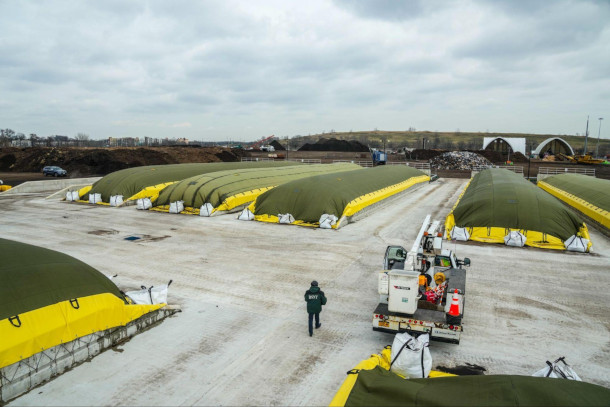
A key facility for NYC’s collected food waste program is the Staten Island Composting Facility. (Photo: Michael Appleton, Mayoral Photography Office, Courtesy of DSNY)
O'NEILL: So how important do you think it is for New York to choose composting through a sort of voluntary or community driven interest, as opposed to a system of penalties and fines?
GOLDSTEIN: Yeah, it really shouldn't be an either or. Both of them are essential. The community composting efforts that have been underway in this city, in neighborhoods across all five boroughs for years and years, have really been fundamental to building up support for composting. They've taught kids about nature. They have in addition to their environmental benefits, they have played a key role in neighborhood revitalization, and so community gardens, community composting, dealing with food scraps in your local neighborhoods, has been a very effective way of getting people involved in nature, addressing the issue and producing the fewest amount of global warming emissions because you're eliminating the transportation costs associated with shipping tons and tons of food waste, you know, hundreds of miles to out of city locations. So there's no substitute for community composting because of all of its environmental benefits and neighborhood revitalization benefits. But ultimately, if we want broad scale participation, we have to make it convenient for residents, and that means collecting it at curbside for those who don't choose to participate in community composting programs. So both are essential. Both are mutually supportive, and both are among the most significant actions all of us could take at home to take a bite out of the climate crisis.
O'NEILL: Well, because Eric, I can only imagine that in a world where the city did not make composting mandatory, it wouldn't suddenly happen that every single New York City resident would wake up one day and go, now I really should be composting, shouldn't I?
GOLDSTEIN: Well, that's correct. It does require an educational effort to explain to people anywhere why you are asking them to take an extra step, an extra minute, and separate their waste into various piles. We know it makes sense economically. Cities that have advanced composting, like Seattle, San Francisco and Portland, they are actually saving money for every ton of food scraps and yard waste that they send to a composting facility, rather than to a landfill and incinerator. So we know it makes sense to compost, but if we want to get everybody to change their behavior, we've got to educate them and explain why it makes sense and how to participate and recognize that that transition will take a little time.
O'NEILL: Well, and this program was rolled out in the five boroughs less than a year ago. So what kind of challenges have you seen or dealt with since then?

Food and organic waste that does not go to the NYC composting facility may end up in wastewater treatment plants. (Photo: Rznagle, Wikimedia Commons, CC BY-SA 4.0)
GOLDSTEIN: Well, like every other thing that we ask New Yorkers to try to do, it's going to take some time to build up full participation. The latest numbers that have come out have suggested that as much as 10% of the food scraps and yard waste that had been previously thrown out and gone to environmentally problematic landfills and incinerators is now being sorted for composting, and that's a good start.
O'NEILL: And as I understand it, the Department of Sanitation has said that a certain amount of collected waste gets sent to a wastewater treatment plant in Brooklyn. What's the story there?
GOLDSTEIN: Well, one other thing that can be done with organic material is to send it to something called an anaerobic digester, anaerobic means in the absence of air. And these digesters are big tanks that are sometimes located at sewage treatment plants, because organic material sewage waste is also an organic material. And so these facilities can capture some of the methane rather than having it escape if you bury food waste in landfills. So on the one hand, sending food scraps to an anaerobic digester is better than burying it in a landfill or trying to burn it in an incinerator. But if you try to mix these food scraps and yard waste with sewage sludge at a wastewater treatment plant, that's problematic, because then you can't use the residue, the sludge that is left over as compostable material, since it's got all of these bad things that end up in our sewage sludge. So, while sending food scraps and yard waste to wastewater treatment plants for anaerobic digestion may be better than sending them to landfills or incinerators, by far and away, the best thing we can do is take all of this food scraps and yard waste and send it to actual composting facilities to be turned into finished compost that can be used to replace chemical fertilizers.
O'NEILL: So Eric, what else would you like listeners to keep in mind when it comes to how we deal with our food waste?
GOLDSTEIN: Well, as important as composting is, the absolute best thing we can do with our food scraps is to generate less of them in the first place. So donating edible food to food pantries, buying only the food we need and will use, putting on our plate only what we can eat. These are ways in which we can address the food waste problem most sustainably, and by doing so, we're also helping address another major problem facing America, which is food insecurity. And so by taking the food that we have that is still edible and making sure that it gets to people who are food insecure, we can be not only addressing the environmental problem but also meeting the needs of people who are food insecure.
O'NEILL: Eric Goldstein is the New York City Environment Director at the Natural Resources Defense Council. Eric, thank you so much for joining us today.
GOLDSTEIN: Thanks for having me.
Related link:
Learn more about NYC’s curbside composting
[MUSIC: Taylor Swift, “Welcome To New York (Taylor’s Version)” on 1989 (Taylor’s Version), Taylor Swift]
Climate-Resilient Coffee
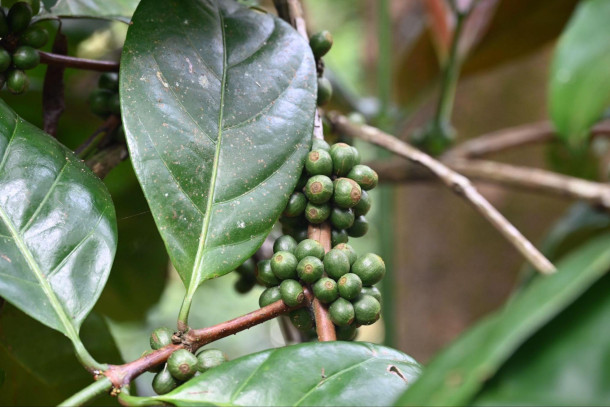
Komal Sable says the excelsa coffee plant is more climate resilient than the arabica and robusta species. (Photo: South India Coffee Company)
[FOLGERS AD]
HUSBAND: Hey, great coffee.
WIFE: It’s instant Folgers. Doesn’t it taste good as fresh perked?
HUSBAND: Better.
WIFE: Better than those girls make at the office?
HUSBAND: Honey, their coffee can’t hold a candle to yours.
O’NEILL: Well, times sure have changed in a lot of ways since the ‘60s, but consumers are still as coffee obsessed as ever. Today the world produces over 24 billion pounds of coffee beans a year and that number is growing. Research has long shown that the top two species, Arabica and Robusta, which make up 99% of the market, are vulnerable to climate impacts like increased drought and heat. And by 2050 as much as half of coffee producing land could no longer be suitable for these top species. But there’s a glimmer of hope for coffee addicts and the farmers who depend on growing coffee for their livelihoods. Living on Earth’s Sophia Pandelidis reports that excitement is brewing over a climate resilient bean called excelsa.
SABLE: To tell you the truth, we've always had excelsa on our farms in India, and the farm that we live on, we've had excelsa on our farm for almost a couple of decades.
PANDELIDIS: Komal Sable runs a fifth generation, 70-acre coffee farm in Coorg, India with her husband, Akshay Dashrath. The farm is nestled in the foothills of the Western Ghats mountains, and Komal says at harvest time, the air there is fragrant with the sweet scent of ripening coffee fruit that holds the beans inside. The duo heads the South India Coffee Company, which sources specialty beans from local Indian farms and distributes them worldwide. Excelsa plants produce beans that can be processed into coffee like Arabica and Robusta. But Komal says excelsa has flown under the radar on most Indian farms, where it’s typically planted to mark borders and stock the family pantry.
SABLE: You know, it was always there at home. And my husband grew up drinking it as well. It was one of those things where we didn't know what to do with it.
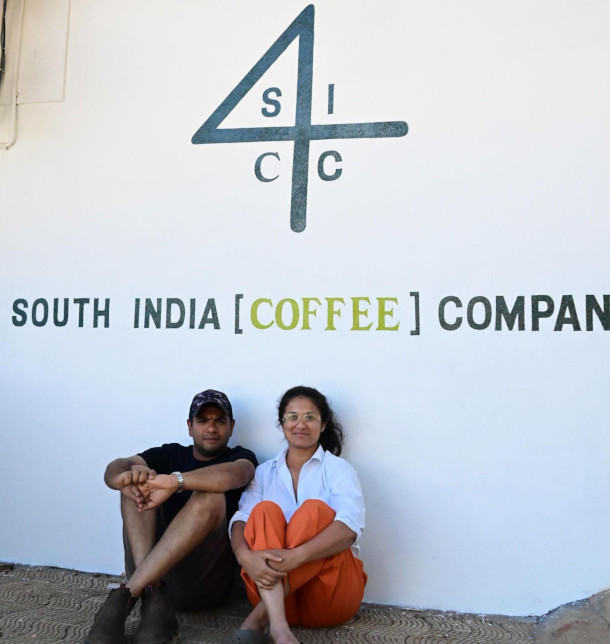
Komal Sable (right) and Akshay Dashrath (left) run the South India Coffee Company in Coorg, India. (Photo: South India Coffee Company)
PANDELIDIS: Excelsa has suffered from coffee wilt disease at times, perhaps making some farmers skeptical of its commercial value. But now climate change is pushing Komal and her team to see this plant in a new light. They noticed that extreme events like heavy rain and drought had little effect on excelsa.
SABLE: We always found that even if the Arabica suffered or the Robusta suffered due to climate change, excelsa was something that would always give us a medium crop without any intervention.
PANDELIDIS: Komal says excelsa is built to withstand climate shocks.
SABLE: They are extremely strong plants.
PANDELIDIS: Deep roots and large, thick leaves increase its ability to access and retain moisture. Those features make the coffee species a prime candidate for climate resiliency. Excelsa plants resemble trees, and tend to be larger than shrub-like Arabica and Robusta, reaching heights of up to 40 feet. Komal says that can make harvesting more labor-intensive, depending on how tall farmers let them grow. But that size has an upside. Bigger plants need more space, leaving room for other crops to grow among them and take advantage of the shade they provide.
SABLE: On our farm, we'll have figs, we'll have jackfruit, we'll have pepper. It's not just coffee.
PANDELIDIS: Komal says agroforestry, where a variety of crops are planted together with trees, is a system used traditionally in India that should be celebrated.
SABLE: It keeps the diversity alive. You have a lot of flora, fauna. You have indigenous species, you have birds that are there. You have this entire ecological system working around it, and it's not a monoculture.
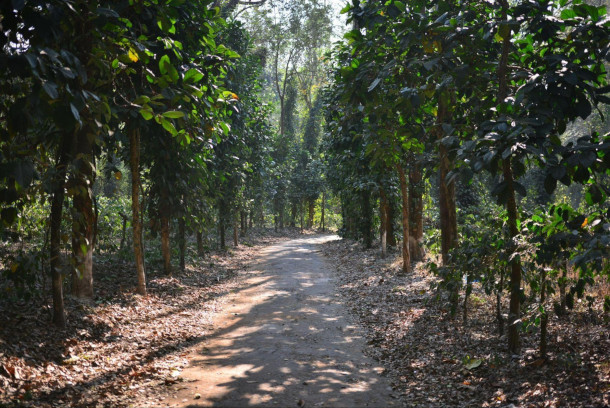
A walkway through the South India Coffee Company’s farm in Coorg, India. (Photo: South India Coffee Company)
PANDELIDIS: Interplanting can also promote nutrient recycling in exhausted soil and naturally restore land. So excelsa is not just climate-smart. It’s regenerative. Now India isn’t the only place where excelsa thrives. Pockets of Indonesia, Vietnam, Guinea, South Sudan, and Uganda are also producing it. Dr. Aaron Davis is keeping an eye on the crop’s international progress. He’s head of coffee research outside of London at The Royal Botanic Gardens Kew. He’s been working with Komal and other farmers across the world to conduct research on excelsa coffee and bring it to the global market. He says it’s still got a long way to go.
DAVIS: If you look at the amount of Excelsa coffee compared to Arabica and Robusta, it's a tiny, tiny percentage, like less than 1% so we're starting from a very, very small base, and it would take some years for it to start coming into the market in significant or substantial volumes.
PANDELIDIS: In the end, Dr. Davis believes climate change could force farmers towards excelsa.
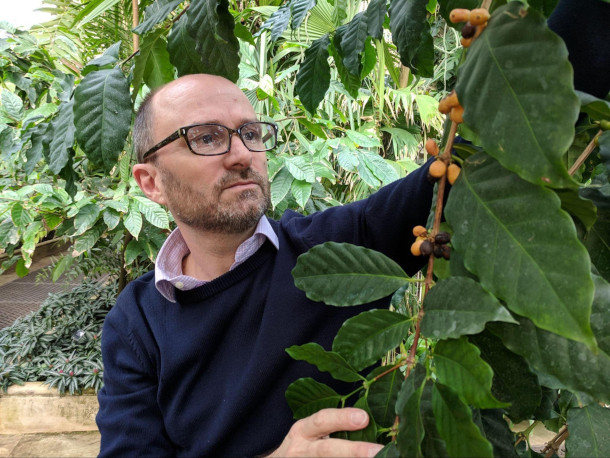
Dr. Aaron Davis is Senior Research Leader for Crops and Global Change at the UK Royal Botanic Gardens, Kew. (Photo: Courtesy of Jenny Williams, RBG Kew)
DAVIS: Sometimes we don't have a choice. I always say that its success will not really depend on the success of excelsa. It will depend on the failure of Arabic and Robusta.
PANDELIDIS: But consumers could also start preferring excelsa all on their own. So far, specialty roasters looking for a niche flavor profile are excelsa’s top customers. That might change as more people get a chance to taste test.
[SFX coffee grinding]
PANDELIDIS: I’ve ground some excelsa beans straight from Komal Sable’s farm in India. And to help out with sampling, I’ve asked my friend Alex who is a coffee connoisseur who orders different kinds of beans from around the world every month.
CAPOZZIELLO: It's got a very strong aroma to it. A mix of sweet, citrus and it's a tad bit nutty.
PANDELIDIS: Yeah, I think I smell the nutty more than the fruity. Maybe you just have a better nose than I do.
[SFX coffee pouring]
CAPOZZIELLO: Cheers!
PANDELIDIS: Cheers!
[SFX sipping]
CAPOZZIELLO: Hmm. It's definitely more sweet than a traditional coffee. It almost has a bourbon smell to it.
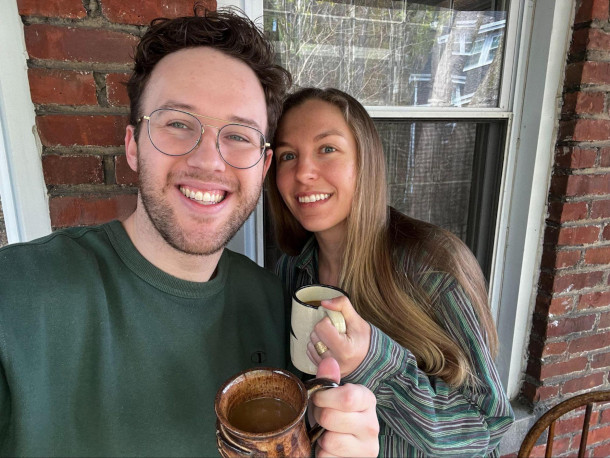
Living on Earth Producer Sophia Pandelidis and her “coffee connoisseur” friend, Alex Capozziello, test out excelsa coffee. (Photo: Alex Capozziello)
PANDELIDIS: Bourbon! I don't know if I can smell it, but I trust you. Honestly, I could maybe drink this black. I actually really like it, genuinely.
CAPOZZIELLO: I think if you're someone who enjoys a diner cup of coffee but wants to elevate it to have a more flavorful premiere taste without going super crazy, this could be a great coffee for you.
PANDELIDIS: I guess it’s official: excelsa is a winner. So maybe consumers will catch on, regardless of climate change. Back in India, Komal is preparing for excelsa’s future.
SABLE: We've been working with a lot of different farms as well, so we're looking at expanding to different plots of lands. People are definitely interested in planting more Excelsa.
PANDELIDIS: And it may not be long before you’re sipping it yourself.
[SFX coffee pouring]
PANDELIDIS: For Living on Earth, I’m Sophia Pandelidis.
Related links:
- Learn more about the South India Coffee Company
- Learn more about Dr. Aaron Davis’ work
[MUSIC: Speedometer, “Kashmir” on Our Kind of Movement, Freestyle Records]
O’NEILL: Just ahead, a breath of fresh air for an environmental justice community that’s been poisoned by a nearby plant for decades. Keep listening to Living on Earth.
ANNOUNCER: Support for Living on Earth comes from the estate of Rosamund Stone Zander - celebrated painter, environmentalist, and author of The Art of Possibility – who inspired others to see the profound interconnectedness of all living things, and to act with courage and creativity on behalf of our planet. Support also comes from Sailors for the Sea and Oceana. Helping boaters race clean, sail green and protect the seas they love. More information @sailorsforthesea.org.
[CUTAWAY MUSIC: Speedometer, “Kashmir” on Our Kind of Movement, Freestyle Records]
Clearing Air in Cancer Alley
Until its announcement on May 13, 2025, the Denka Performance Elastomer plant in LaPlace, Louisiana manufactured neoprene, a synthetic rubber that is found in products such as wetsuits and laptop sleeves. The manufacturing process emitted chloroprene, a cancer-causing chemical, among other pollutants. (Photo: Andrew J. Skerritt)
O’NEILL: It’s Living on Earth, I’m Aynsley O’Neill.
DOERING: And I’m Jenni Doering.
Just two months after the Trump administration announced plans to drop a Biden-era lawsuit against Denka Performance Elastomer, residents of Reserve, Louisiana were greeted with stunning news. The plant’s Japanese owners said that they were indefinitely suspending operations of its manufacturing of neoprene, used in laptop sleeves and wetsuits. The predominantly Black community of Reserve in St. John the Baptist Parish is in what’s known as Cancer Alley, in the shadow of petrochemical plants emitting cancer-causing air pollutants. Many residents of Reserve are descended from enslaved people who toiled on sugar plantations. In fact, Dupont constructed the plant in 1968 on a former sugar plantation and sold it to Denka a decade ago while retaining ownership of the land itself. For years, Tish Taylor, her father Robert Taylor ,and their organization, Concerned Citizens of St. John have been advocating to curb air pollution from the plant. Their efforts were aided by the Biden EPA and Department of Justice, which sued Denka in early 2023, alleging that the plant posed unacceptable cancer risks. But the Trump administration dropped that case as part of its dismantling of environmental justice initiatives designed to reduce the exposure of low-income and communities of color to industrial air and water pollution. Tish Taylor joins me now. Tish, welcome to Living On Earth!
TAYLOR: Thank you so much for having me.
DOERING: So how did you learn about Denka's plans to suspend its operations indefinitely?
TAYLOR: Oh, what a wonderful day. Well, I received an email from one of our environmental justice leaders from the Sierra Club saying that they were supposed to be releasing a statement. And not long after I read the email, a text message popped up with the link to their website, with their final statement, saying that they were going to not restart the plant after that shutdown. They were not going to restart the neoprene plant, and I didn't know how to feel at first, because, you know, this has been such a long battle with them spending lots of money on their lawyers and everybody, scientists, everyone. The battle was so long, and I never thought that they would actually say, ah, we just we quit. But, you know, it was because of money, you know, more than anything. But we affected that. We affected it at every level we could. We fought them. And I was elated. I couldn't believe it. And I jumped out the bed. I ran over to my dad, to his room, and he's like, looking at it in his hand on his phone. And I'm like, Daddy, this city is shutting down indefinitely. I don't believe this, you know. And he's like, I don't know, you know, because you don't, you're scared, you know. But it was, it was real. It was a declaration on the statement on their website. Oh, my God. It was so wonderful. I mean, I went outside, I smelled my flowers. I couldn't even wipe the smile off of my face. It was unbelievable. I love my flowers. I love my garden. And every time I go out there, that's normally my refuge, my plants. And I would go out, water them, talk to them, of course, weed them. And I would always have this little nagging thing behind me saying, you're breathing chloroprene. You, how much? What's the levels today? I wonder how much they poisoning us today?
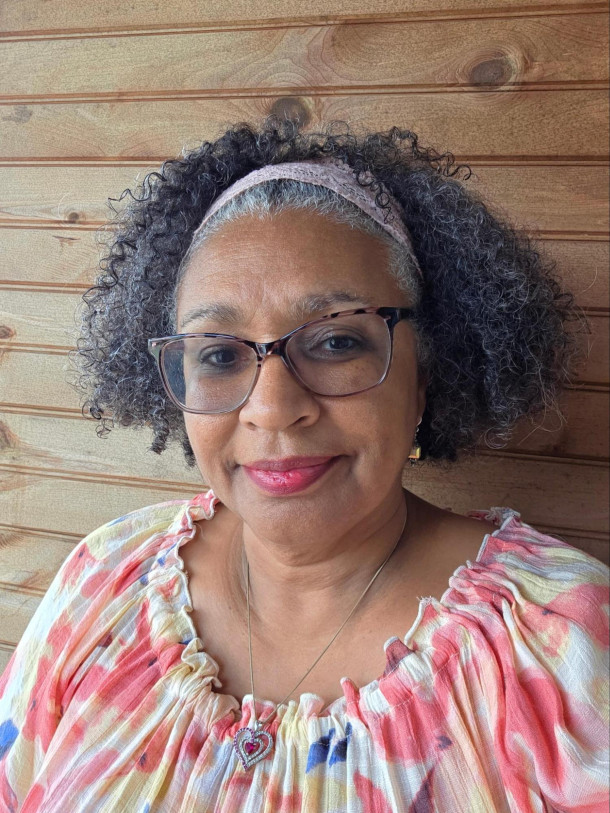
Tish Taylor is the program director of Concerned Citizens of St. John, an environmental advocacy group fighting to reduce pollution by Denka and other petrochemical plants in the Cancer Alley community of LaPlace, Louisiana. With Denka announcing the suspension of operations, Taylor said she can go outside and tend to her garden in chloroprene free air. (Photo: Tish Taylor)
DOERING: Remind us why was that so concerning? Knowing that you were breathing in chloroprene?
TAYLOR: We found out that chloroprene changes your DNA. It's a mutagen. I have this perfect grandson. He's three years old now. Of course, he was born premature, because that's very common in Cancer Alley, low birth weight, but he also had little patches of eczema, and he's autistic. But knowing that he was coming home to the exposures of chloroprene and understanding that in two years of his life, he would have exceeded his lifetime levels of exposure to chloroprene at two years old.
DOERING: Wow.
TAYLOR: So he already has that because he's three now. He's been exposed.
DOERING: Now Tish, I understand that living in reserve next to Denka and other Cancer Alley petrochemical plants has really exacted a price on you and your family. Can you please tell us about that?
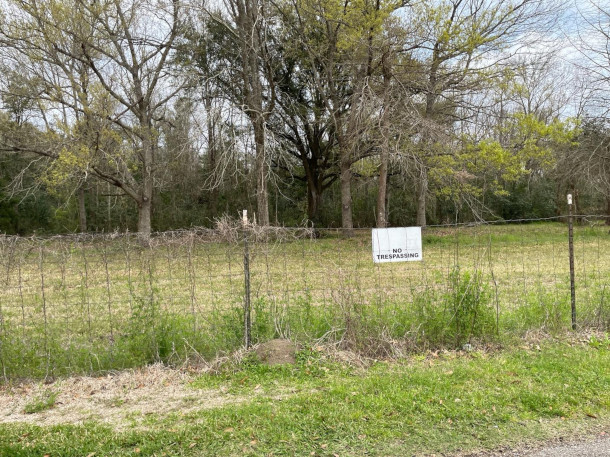
The fence surrounding the Denka plant sits across the street from homes in Reserve, Louisiana. (Photo: Andrew J. Skerritt)
TAYLOR: So we have unbelievable amounts of illnesses. My mom is a breast cancer survivor, later diagnosed with multiple sclerosis and heart disease. So for 22 years, we were in and out of hospitals with her, and she passed away this, this December, December, 31. Twenty two years of suffering, no quality of life. You have to understand. Grasping at good days and struggling through bad days. My sister has a very rare autoimmune disease, and that's very common in my community.
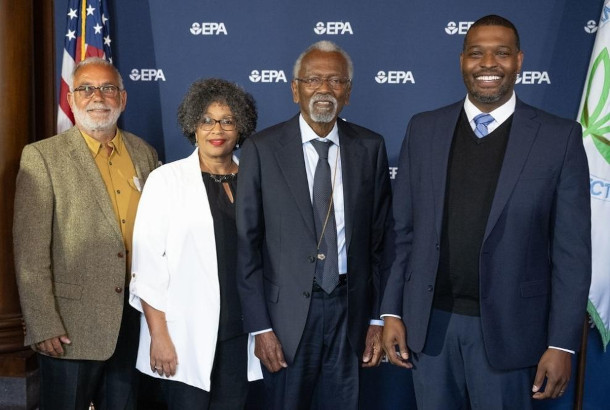
Tish (center left) and Robert Taylor (center right) and Concerned Citizens of St. John Board Member Larry Saropuru (left) celebrate the signing of the HON Rule with then-EPA Administrator Michael S. Regan (right) in 2024. The rule aims to reduce emissions of hazardous air pollutants (HAPs) from chemical plants. This photo was originally posted on the EPA website but has since been removed. (Photo: EPA, public domain)
DOERING: You know, you mentioned that the struggle against the Denka plant's emissions was so hard. What was that struggle like?
TAYLOR: Well, EPA gave them a goal. They had to lower their emissions of chloroprene to 0.2 micrograms per cubic meter of air. At that time, they were emitting 400 to 800 micrograms per cubic meter of air. So now you have to go from hundreds to two tenths of a microgram. Of course, they started fighting it. They said that EPA was wrong. Their science says everything is great. We are healthy. So we started. We started just advocating. My dad started the organization. My dad, Robert Taylor, is the founder and executive director. We started having meetings. We had a scientist to come down and give us the information, because they were forced to put monitors all around and share that information. So we started putting together marches to the state capitol, because we knew that without the Louisiana Department of Environmental Quality actually regulating, that it would not happen. And we all know the history of LDEQ was that they were pro industry. So marching to our governor, saying, 'You need to protect us. You need to come in and do this.' We held meetings with the School Board to let the parents know and the School Board know that they needed to be aware of the chemicals that the students at Fifth Ward Elementary, which was less than 1200 feet away from the plant that they were exposed to. These are children from kindergarten to fourth grade. So we wanted them to know, and we held community meetings. We went to the Parish Council meeting, Parish Council meeting and the School Board. The head of LDEQ actually attended those meetings and said that we were lying, that my dad was a fear monger disseminating mistruths. And the Department of Health, the head of the Department of Health attended the Parish Council meeting and said that, the first one said, there is no safe level of chloroprene, and it actually covers the entire parish. And he had to resign. The new one came and said that we were actually exaggerating the numbers and the health risks of it. So we had the state Health Department and LDEQ actually lying to the community, and that's who community is supposed to trust, you know? And we had the governor totally ignoring us, but EPA came in and they started investigating, and that's a whole other story.
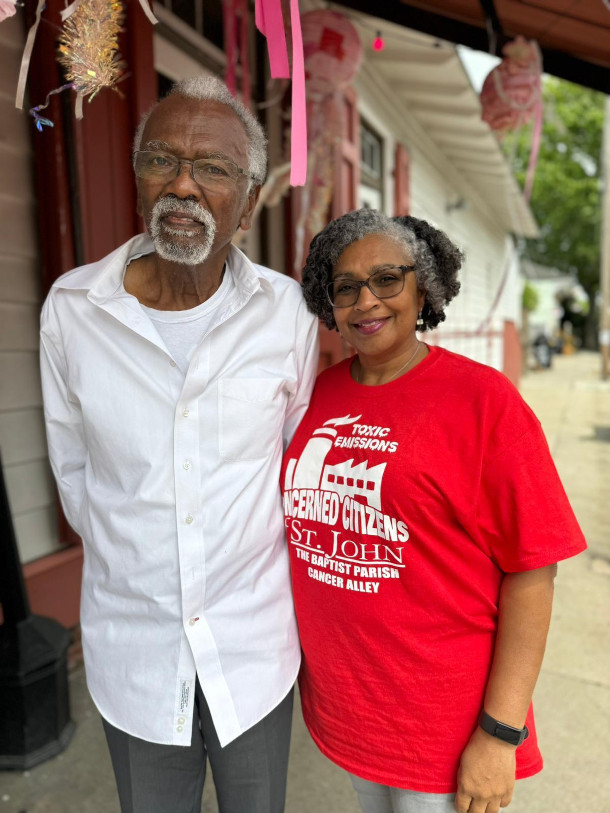
Tish Taylor (right), alongside her father, Robert Taylor (left), who founded the advocacy group Concerned Citizens of St. John in 2016. (Photo: Tish Taylor)
DOERING: What has been the reaction of local St John Parish officials and Denka supporters to the plant's production halt?
TAYLOR: Our parish president said that we're going to lose $2 million in taxes, which it should have been about 200 million over the last 10 years or so. You know, you give those people tax breaks, and $2 million is a drop in the bucket, and we don't see it anyway, so we don't care. And of course, she was concerned about the jobs. The community was worried about the jobs of the contractors, you know? What happens to those people? And then we have people who are giving us hugs and high fives, and 'Y'all are great. We're so happy that y'all did this because we don't have the poison.' So it's a mixed group, but we know what we did was for everyone in this parish, and that it benefited them. Their opinion, whether it's positive or negative, has no bearing on the outcome of our advocacy, because we did that. We did that. I'm just so happy that we went all around full circle in our advocacy to make sure we affected them every way that we could. Because in the meantime, we're dying. In the meantime, a new baby is being born and brought here to be exposed. So it was just important to just make sure that this was not gonna happen anymore. And that's what happened. They shut down.
DOERING: Now. Tish, you know now that Denka has announced plans to suspend their operations for now, what concerns do you have over the future of the plant?

Four generations of Taylors: Robert Taylor (center), Tish Taylor (right), her daughter Teesha (left), and grandson Cairo (front center) live in LaPlace, Louisiana, which has some of the highest exposure to cancer causing chemicals such as chloroprene and ethylene dioxide. (Photo: Tish Taylor)
TAYLOR: Well, Denka actually leases the neoprene plant facility itself from DuPont. So DuPont is still connected. They're still running. It's on their site. So they're decommissioning right now, so we have to make sure that they're actually removing the chemicals, making it safe. And you know, after they leave, we don't want a Superfund site. But ultimately, they said they're not going to restart the plant indefinitely, but they are definitely trying to see if they can sell it to someone else. So we are concerned now with, who you're going to sell it to, and how can we make sure that they don't get any permits to come in if they're going to do something that's even more toxic or even the same. It has the same effect on our community. So we have to watch now, they are getting permits to remove 1-3 Butadiene from the plant, which is good. It's another one of those bad chemicals. So we know that they are actually in the process of removing and doing the cleanup. But we're trying to schedule a meeting with the parish council members to find out if they're actually actively watching the decommissioning of the plant, or if they're just leaving it up to them. Because if they are, they can just back out anytime and leave a toxic mess. So the advocacy never ends. We want that place cleaned up, and we don't want anything else that's coming in that's going to hurt us.
DOERING: So you know, the Trump administration, it scuttled the Biden legal action on enforcement against Denka. It also moved to cut funding for environmental justice groups like yours across the country. It's also conflating environmental justice with what it calls “illegal DEI,” diversity, equity and inclusion. How is all this affecting your organization's ability and will to fight?

Exposure to pollutants has taken a heavy toll on Tish Taylor (right) and her family. Robert Taylor’s late wife, Zenobia (center), battled cancer and other illnesses, while his other daughter Raven (left), is struggling with auto-immune illness. (Photo: Tish Taylor)
TAYLOR: Well, when we first started, there was no money, okay? And, you know, you just start by philanthropy, you know, giving donations. So when the Biden administration showed up, it was like an injection of adrenaline. It was like, here we go. We acknowledge this. It's real. Let's do something about it. And they started working on this IRA, all of this stuff was wonderful. The thing about it is, as Dr. Beverly Wright stated, we didn't have money before, and we did it, and we're not going to stop ever. So we got the boost. It was great, but we still move on in the advocacy and we find a way.
DOERING: So before you go Tish, what have you learned from this Denka struggle, and what gives you hope amid all of this environmental injustice and environmental racism that you've experienced?
TAYLOR: Well, I can tell you that my next grandchild won't come home to chloroprene, and that is what matters. We made a difference, and we're going to make a difference, and it doesn't matter who knows or who sees it, or who doesn't smell a particular chemical all of a sudden, because it's not about that; it's about that it's not there, and the advocacy has to continue. I cannot ignore it. Either you have it in you or you don't, and if it's in you, you're gonna just step out to the forefront and say, Okay, this is my job now. I fight for environmental justice. We need to live. We need to live clean. And at first I could not get out of the bed in the morning, the struggle to just get up knowing, first of all that it's real, it's true. We've been poisoned all our lives. My sister is sick because of this. My mama died because of this. My neighbors are dying. We're burying people every week because of this? For somebody else to make billions of dollars? You have no choice but to get up and fight, because you know better. You know you deserve better. You know your people deserve better. So it has to continue, because it's always going to be something. So if you're strong enough to fight, you fight, and if you need to retreat and take care of yourself, then you retreat. But then you come right back out strong and you fight again, because you have to for the next generation and the next generation and for this Earth. You have to do it.
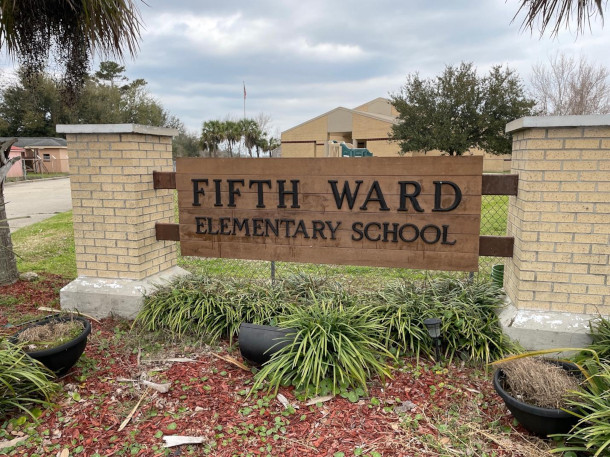
Generations of Reserve children have attended school in the building that housed Fifth Ward Elementary. The school sits on the fence line of the Denka property. (Photo: Andrew J. Skerritt)
DOERING: It takes a lot of courage to keep showing up for that fight.
TAYLOR: It takes a lot of courage to get up and know what's going on every day, and to get out the bed and just do your daily everything. It takes courage. Black people courageous. This is a world that we fight every day that's built to kill us, to kill our spirit. We don't have a choice but to be courageous. There's no other option but to be courageous. I'm no stronger than anybody else. I just picked up this one, this torch, but sometimes just picking your head up off the pillow is a lot.
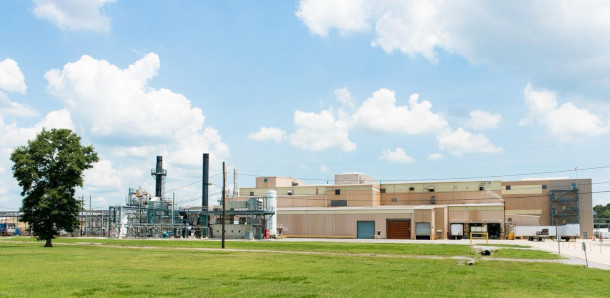
Reserve, Louisiana is home to other companies whose emissions worry Tish Taylor and members of Concerned Citizens of St. John. In 2023, the U.S. Environmental Protection Agency reached a settlement with Evonik Industries to reduce emissions of ethylene oxide and other hazardous air pollutants by 5.6 tons per year. (Photo: Courtesy of Evonik Industries AG)
DOERING: Tish Taylor is Program Director of Concerned Citizens of St John. Thank you so much, Tish, for sharing your story.
TAYLOR: You're welcome. I'm so happy to be here. Honored for you to actually listen to our story.
Related links:
- The Guardian | “Louisiana: Controversial Denka Plant Suspends Production After Dire Losses”
- Click here to read Denka’s statement about the suspension of production
- Earth Justice | ”In Louisiana’s Cancer Alley, a Deserved Reprieve for St. John Residents After Years of Environmental Injustice”
[MUSIC: Bryan New, Andrew Duck MacDonald, “Hope Lives Here” on Filmscore: Atmospheres, First Com Music]
O’NEILL: Living on Earth is produced by the World Media Foundation.
Our crew includes Naomi Arenberg, Paloma Beltran, Daniela Faria, Swayam Gagneja, Mark Kausch, Mark Seth Lender, Don Lyman, Ashanti Mclean, Nana Mohammed, Sophia Pandelidis, Frankie Pelletier, Jake Rego, Andrew Skerritt, Bella Smith, Melba Torres, and El Wilson.
DOERING: Tom Tiger engineered our show. Alison Lirish Dean composed our themes. You can hear us anytime at L-O-E dot org, Apple Podcasts and YouTube Music, and like us please, on our Facebook page, Living on Earth. Find us on Instagram @livingonearthradio, and we always welcome your feedback at comments@loe.org. Steve Curwood is our Executive Producer. I’m Jenni Doering.
O’NEILL: And I’m Aynsley O’Neill. Thanks for listening!
ANNOUNCER: Funding for Living on Earth comes from you, our listeners, and from the University of Massachusetts, Boston, in association with its School for the Environment, developing the next generation of environmental leaders. And from the Grantham Foundation for the protection of the environment, supporting strategic communications and collaboration in solving the world’s most pressing environmental problems.
ANNOUNCER 2: PRX.
Living on Earth wants to hear from you!
Living on Earth
62 Calef Highway, Suite 212
Lee, NH 03861
Telephone: 617-287-4121
E-mail: comments@loe.org
Newsletter [Click here]
Donate to Living on Earth!
Living on Earth is an independent media program and relies entirely on contributions from listeners and institutions supporting public service. Please donate now to preserve an independent environmental voice.
NewsletterLiving on Earth offers a weekly delivery of the show's rundown to your mailbox. Sign up for our newsletter today!
 Sailors For The Sea: Be the change you want to sea.
Sailors For The Sea: Be the change you want to sea.
 The Grantham Foundation for the Protection of the Environment: Committed to protecting and improving the health of the global environment.
The Grantham Foundation for the Protection of the Environment: Committed to protecting and improving the health of the global environment.
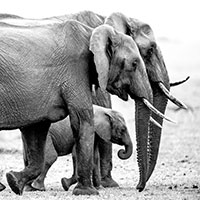 Contribute to Living on Earth and receive, as our gift to you, an archival print of one of Mark Seth Lender's extraordinary wildlife photographs. Follow the link to see Mark's current collection of photographs.
Contribute to Living on Earth and receive, as our gift to you, an archival print of one of Mark Seth Lender's extraordinary wildlife photographs. Follow the link to see Mark's current collection of photographs.
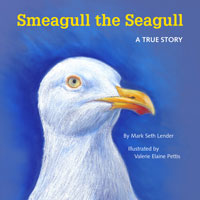 Buy a signed copy of Mark Seth Lender's book Smeagull the Seagull & support Living on Earth
Buy a signed copy of Mark Seth Lender's book Smeagull the Seagull & support Living on Earth

